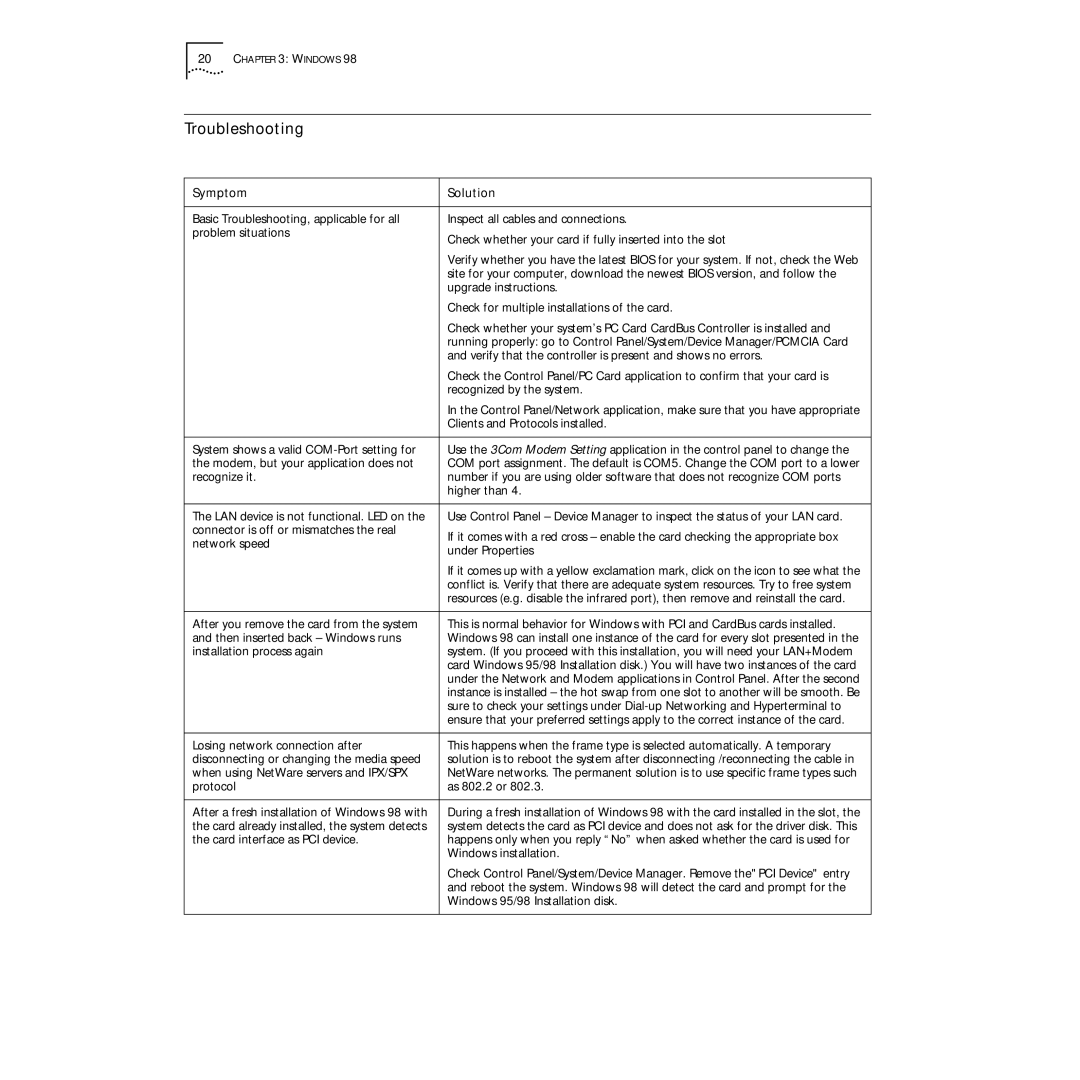
20CHAPTER 3: WINDOWS 98
Troubleshooting
Symptom | Solution | |
|
| |
Basic Troubleshooting, applicable for all | Inspect all cables and connections. | |
problem situations | Check whether your card if fully inserted into the slot | |
| ||
| Verify whether you have the latest BIOS for your system. If not, check the Web | |
| site for your computer, download the newest BIOS version, and follow the | |
| upgrade instructions. | |
| Check for multiple installations of the card. | |
| Check whether your system’s PC Card CardBus Controller is installed and | |
| running properly: go to Control Panel/System/Device Manager/PCMCIA Card | |
| and verify that the controller is present and shows no errors. | |
| Check the Control Panel/PC Card application to confirm that your card is | |
| recognized by the system. | |
| In the Control Panel/Network application, make sure that you have appropriate | |
| Clients and Protocols installed. | |
|
| |
System shows a valid | Use the 3Com Modem Setting application in the control panel to change the | |
the modem, but your application does not | COM port assignment. The default is COM5. Change the COM port to a lower | |
recognize it. | number if you are using older software that does not recognize COM ports | |
| higher than 4. | |
|
| |
The LAN device is not functional. LED on the | Use Control Panel – Device Manager to inspect the status of your LAN card. | |
connector is off or mismatches the real | If it comes with a red cross – enable the card checking the appropriate box | |
network speed | ||
under Properties | ||
| ||
| If it comes up with a yellow exclamation mark, click on the icon to see what the | |
| conflict is. Verify that there are adequate system resources. Try to free system | |
| resources (e.g. disable the infrared port), then remove and reinstall the card. | |
|
| |
After you remove the card from the system | This is normal behavior for Windows with PCI and CardBus cards installed. | |
and then inserted back – Windows runs | Windows 98 can install one instance of the card for every slot presented in the | |
installation process again | system. (If you proceed with this installation, you will need your LAN+Modem | |
| card Windows 95/98 Installation disk.) You will have two instances of the card | |
| under the Network and Modem applications in Control Panel. After the second | |
| instance is installed – the hot swap from one slot to another will be smooth. Be | |
| sure to check your settings under | |
| ensure that your preferred settings apply to the correct instance of the card. | |
|
| |
Losing network connection after | This happens when the frame type is selected automatically. A temporary | |
disconnecting or changing the media speed | solution is to reboot the system after disconnecting /reconnecting the cable in | |
when using NetWare servers and IPX/SPX | NetWare networks. The permanent solution is to use specific frame types such | |
protocol | as 802.2 or 802.3. | |
|
| |
After a fresh installation of Windows 98 with | During a fresh installation of Windows 98 with the card installed in the slot, the | |
the card already installed, the system detects | system detects the card as PCI device and does not ask for the driver disk. This | |
the card interface as PCI device. | happens only when you reply “No” when asked whether the card is used for | |
| Windows installation. | |
| Check Control Panel/System/Device Manager. Remove the"PCI Device" entry | |
| and reboot the system. Windows 98 will detect the card and prompt for the | |
| Windows 95/98 Installation disk. | |
|
|
